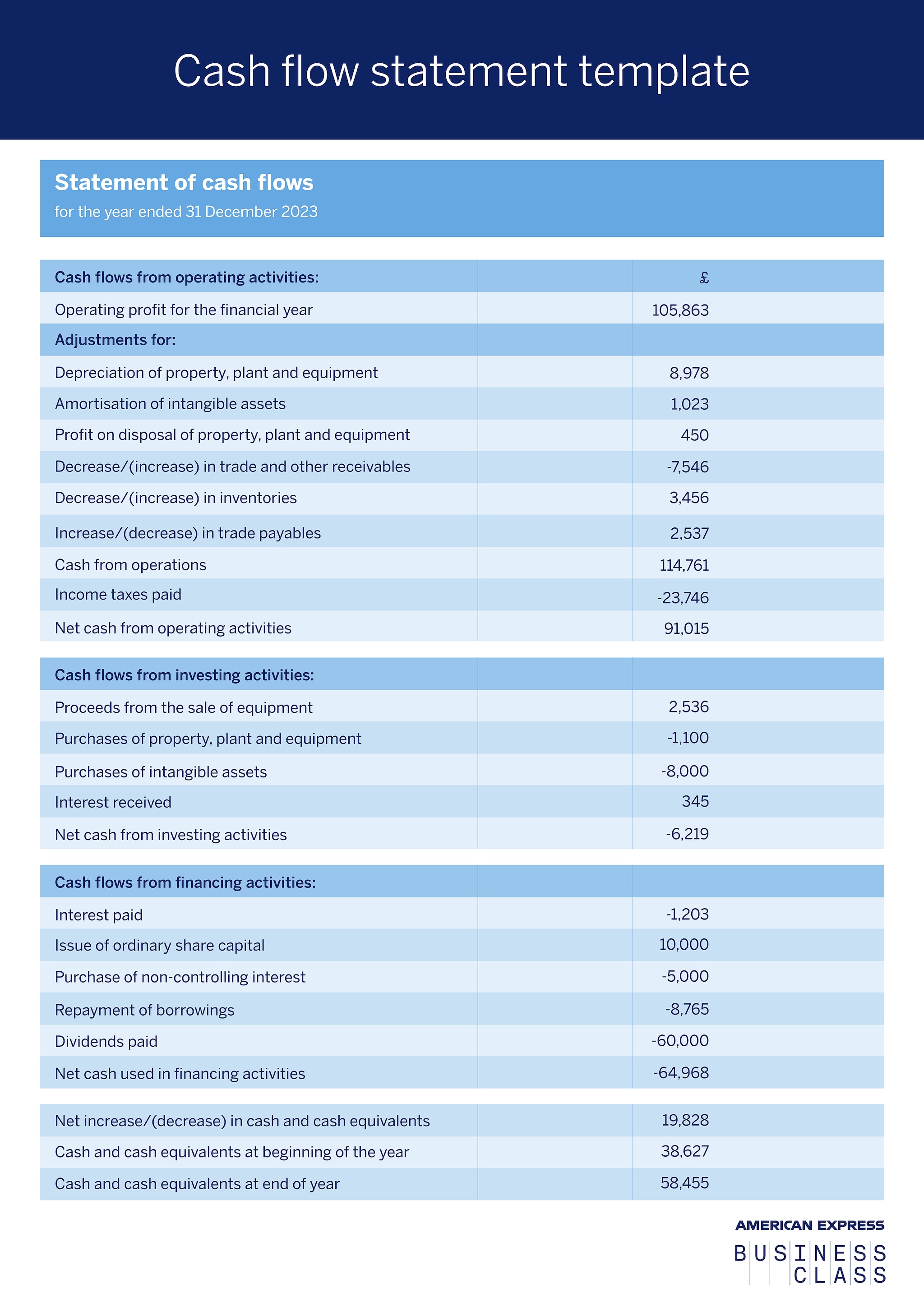Every small business owner knows that cash is king, but many face problems at some point – 60% of small businesses have reported struggling with cash flow, and 72% of those say it has disrupted their operations [1].
So, how can you keep track of the cash flowing in and out of your business? What tools can you use to help ensure your business has enough cash, not just to survive, but to grow and expand? And what metrics will lenders and investors want to see?
Here’s a run-down of the key formulae that small business owners need.
How to calculate net cash flow
Net cash flow is the difference between all the company’s cash inflows and cash outflows in a given period. It’s a key indicator of a company’s financial health.
Net cash flow formula
To calculate net cash flow, simply subtract the total cash outflow by the total cash inflow.
Net Cash Flow = Total Cash Inflows – Total Cash Outflows
Balancing cash inflow and outflow is vital to maintaining a healthy business. The American Express® Business Gold Card helps you to maintain this balance by offering a payment period of up to 54 days¹, which allows you more time to gather payments before your own are due.
Net cash flow example
If Company A had:
- £150,000 cash inflow
- £100,000 cash outflow
- Net cash flow would be £50,000.
Cash Inflow (£150,000) - Cash Outflow (£100,000) = Net Cash Flow (£50,000).
It’s also possible to calculate net cash flow by adding the total value of three variables that already account for cash inflows and outflows:
Net Cash Flow = Operating Cash Flow + Cash Flow from Financial Activities (Net) + Cash Flow from Investing Activities (Net)
Why is it important to calculate cash flow?
Routinely calculating your cash flows using this formula or one of the others listed below can ensure you don't encounter any cash flow problems and maintain an accurate picture of your business’s financial health.
How to calculate operating cash flow
Operating cash flow (OCF) gives a picture of the company’s ability to generate cash from its normal operations.
Operating cash flow formula
To calculate operating cash flow, add your net income and non-cash expenses, then subtract the change in working capital.
Operating Cash Flow = Net Income + Non-Cash Expenses – Change in Working Capital
These can all be found in a cash flow statement.
Operating cash flow example
If Company B had:
- £250,000 net income
- £100,000 non-cash expenses
- £50,000 change in working capital
- Operating cash flow would be £300,000.
Net Income (£250,000) + Non-cash Expenses (£100,000) - Change in Working Capital (£50,000) = Operating Cash Flow (£300,000).
How to calculate cash flow from financing activities
Cash flow from financing activities (CFF) is the net flow of cash between the company and its owners, creditors, and investors. It reflects the company’s financing mix.
Cash flow from financing activities formula
To calculate cash flow from financing activities, add your dividends paid to the repurchase of debt and equity, then subtract the total number from cash inflows from issuing equity or debt.
Financing Cash Flow = Cash Inflows from Issuing Equity or Debt - (Dividends Paid + Repurchase of Debt and Equity)
These can also be found in a cash flow statement.
Cash flow from financing activities example
If Company C had:
- £150,000 cash inflows from issuing equity of debt
- £20,000 dividends paid
- £50,000 repurchase of debt and equity
- Cash flow from financing activities would be £80,000.
Cash Inflows from Issuing Equity of Debt (£150,000) - (Dividends Paid (£20,000) + Repurchase of Debt and Equity (£50,000)) = Cash Flow from Financing Activities (£80,000).
How to calculate cash flow from investing activities
Cash flow from investing (CFI) is the net cash inflow or outflow from capital expenditures, mergers & acquisitions, and purchase/sale of marketable securities.
Cash flow from investing activities formula
To calculate cash flow from investing activities, add the purchases or sales of property and equipment, other businesses, and marketable securities.
CFI = Purchase/Sale of Property and Equipment + Purchase/Sale of Other Businesses + Purchase/Sale of Marketable Securities
These items are all listed in a cash flow statement, but can also be identified by comparing non-current assets on the balance sheet over two periods.
Cash flow from investing activities example
If Company D had:
- £50,000 purchase/sale of property and equipment
- £75,000 purchase/sale of other businesses
- £25,000 purchase/sale of marketable securities
- Cash flow from investing activities would be £150,000.
Purchase/Sale of Property and Equipment (£50,000) + Purchase/Sale of Other Businesses (£75,000) + Purchase/Sale of Marketable Securities (£25,000) = Cash Flow from Investing Activities (£150,000).
How to calculate free cash flow (FCF)
'Free cash' is the cash left over after the business has met all its obligations. It's essential to planning future spending as it shows how much cash a business has at its disposal.
Free cash flow formula
To calculate free cash flow, add your net income and non-cash expenses, then subtract your change in working capital and capital expenditure.
Free Cash Flow = Net Income + Non-Cash Expenses - Change in Working Capital - Capital Expenditure
Free cash flow example
If Company E had:
- £200,000 net income
- £100,000 non-cash expenses
- £125,000 increase in working capital
- £50,000 capital expenditure
- Free cash flow would be £125,000.
Net Income (£200,000) + Non-cash Expenses (£100,000) - Increase in Working Capital (£125,000) - Capital Expenses (£50,000) = Free Cash Flow (£125,000).
You can also calculate free cash flow by taking the cash generated from normal business operations and subtracting capital expenditure, which is the money generated acquiring or maintaining fixed assets:
Free Cash Flow = Operating Cash Flow - Capital Expenditure
All this information can be obtained from an income statement.
- Net income is the bottom line.
- Non-cash expenses include depreciation, amortisation, and taxes.
- Working capital is the difference between the company’s current assets and liabilities.
Capital expenditure can also be found on a cash flow statement. Basic FCF doesn’t include changes in debt, so when a company takes on new debt, basic free cash flow for that period can be misleadingly positive. Therefore, levered free cash flow, also known as free cash flow to equity (FCFE), can be more accurate.
FCFE = Free Cash Flow - (Debt Issued - Debt Repaid)
Debt issued and repaid in the period can be found on a cash flow statement.
Investors use 'unlevered' free cash flow, also known as free cash flow to the firm (FCFF), when estimating a company’s enterprise value. FCFF is a hypothetical measure of the free cash that the company would have available if it had no debt. It enables companies with very different capital structures to be directly compared for valuation purposes.
To calculate FCFF, first calculate earnings before interest and taxes (EBIT).
EBIT = Net income - Interest - Taxes
Now, recalculate the taxes line on the income statement to exclude the interest element (since interest on debt typically incurs tax relief). Then recalculate operating cash flow (see formula above) with the new tax figure. Finally, apply the FCF formula to give the FCFF figure.
How to prepare a cash flow statement
Routinely calculating your cash flows using the formulae above can ensure you don't encounter any cash flow problems and maintain an accurate picture of your business’s financial health.
However, Companies House and HMRC will also need to review your cash flow statements annually, and it will need to detail cash flow from operations, investment and financing - so knowing how to calculate all three is vital.
Cash flow statements are vital because they take the Financial Performance presented in the P&L and provide a "cash-adjusted view".
Your accounting software will usually have a cash flow statement feature, so providing that your books are up-to-date, the statement will be automatically generated for you. If your accounting software doesn’t have this feature, download your main P&L account and balance sheet and use a cash flow statement template like the one below.
 |
1. The maximum payment period is 54 days and is obtrained only if you spend on the first day of the new statment period and repay the balance in full on the due date. If you'd prefer a Card with no annual fee, rewards or other feautres, an alternative option is available - The Business Basic Card.
Sources:
[1] Quickbooks, Small business payments and cash flow in 2021



